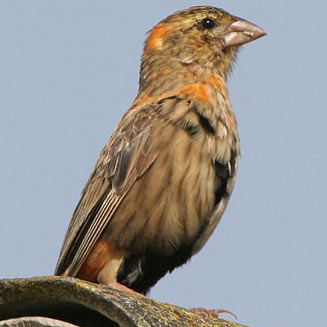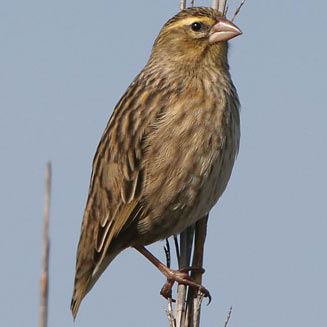|
Euplectes orix (Southern red
bishop, Red bishop)
Rooivink [Afrikaans]; Intakomlilo, Ucumse, Umlilo
[Xhosa]; iBomvana, iNtakansinsi, isiGwe [Zulu]; Gomugeha [Kwangali];
Khube, Thaha-khube, Thaha-khubelu [South Sotho]; Thagalehlaka [North
Sotho]; Chikenya [Shona]; MohubÍ, Thaga [Tswana]; Grenadierwever [Dutch];
Euplecte ignicolore [French]; Oryxweber [German];
Cardeal-tecel„o-vermelho [Portuguese]
Life
> Eukaryotes >
Opisthokonta
> Metazoa (animals) >
Bilateria >
Deuterostomia > Chordata >
Craniata > Vertebrata (vertebrates) > Gnathostomata (jawed
vertebrates) > Teleostomi (teleost fish) > Osteichthyes (bony fish) > Class:
Sarcopterygii (lobe-finned
fish) > Stegocephalia (terrestrial
vertebrates) > Tetrapoda
(four-legged vertebrates) > Reptiliomorpha > Amniota >
Reptilia (reptiles) >
Romeriida > Diapsida > Archosauromorpha > Archosauria >
Dinosauria
(dinosaurs) > Saurischia > Theropoda (bipedal predatory dinosaurs) >
Coelurosauria > Maniraptora > Aves
(birds) >
Order: Passeriformes > Family: Ploceidae
> Genus: Euplectes
 |
 |
|
Southern red bishop male in breeding plumage,
South Africa. [photo
Callie de Wet ©] |
Southern red bishop male in transisitional
plumage, Koeberg Nature Reserve, South Africa. [photo Trevor Hardaker ©] |
 |
 |
|
Southern red bishop male
in non-breeding plumage, Kalbaskraal, South Africa. [photo Trevor Hardaker ©] |
.Southern red bishop female, Koeberg Nature
Reserve, South Africa. [photo Trevor Hardaker ©] |
Distribution and habitat
Occurs from Tanzania through Zambia and Angola to southern
Africa, where it is especially common in Zimbabwe and South Africa. It generally
prefers open grassland, marshes and cultivated areas, often near perennial water
bodies. It is a major crop pest in the wheatlands of the Western Cape, where
mist nets are used to keep them under control.
|
 |
|
Distribution of Southern red bishop in southern Africa,
based on statistical smoothing of the records from first SA Bird Atlas
Project (©
Animal Demography unit, University of
Cape Town; smoothing by Birgit Erni and Francesca Little). Colours range
from dark blue (most common) through to yellow (least common).
See here for the latest distribution
from the SABAP2. |
Predators and parasites
- Predators
- of adults
- of chicks and eggs
Brood parasites
It has been recorded as host of the
Diderick
cuckoo.
Food
It mainly eats seeds and other plant matter, with
invertebrates taking up only about 0.5% of its diet. It does most of its
foraging in flocks, plucking food items from the ground and perching in
vegetation. The following food items have been recorded
in its diet:
- Plants
- seeds
- Zea mays (Maize)
- Eragrostis curvula (Weeping lovegrass)
- Setaria flabellate (Creeping setaria)
- Panicum maximum (Guinea grass)
- Eleusine indica (Goose grass)
- Triticum (wheat)
- flowers
- Melinis repens (Natal redtop)
- Leonotis (wild dagga)
- Phragmites australis (Common reed)
- Invertebrates
- insects
-
spiders
- Talorchestia (sandhoppers)
Breeding
- Polygynous, highly territorial colonial nester, as a successful male may
mate with 3-8 females in a breeding season. It usually breeds in noisy
colonies in reedbanks, with each male vigorously defending his territory
against other males and Euplectes species.
- The male builds about 3-13 nests per breeding season, with each taking
about 1-3 days to complete, tightly weaving thin strips of reeds and grass
to form an oval-shaped structure with a side entrance covered by a hood. It
is typically attached to reeds, sedges or bulrushes, or occasionally in
crops such as maize.
- Egg-laying season almost year-round, peaking from November-February.
- It lays 1-5 eggs, which are incubated solely by the female for about
12-13 days.
- The chicks are fed by the female only, leaving the nest after about
11-15 days.
Threats
Not threatened.
References
-
Hockey PAR, Dean WRJ and Ryan PG 2005. Roberts
- Birds of southern Africa, VIIth ed. The Trustees of the John Voelcker
Bird Book Fund, Cape Town.
|
